曼昆经济学原理第5版微观PPT第十四章(14)免费中文版
曼昆经济学第14章 竞争市场上的企业
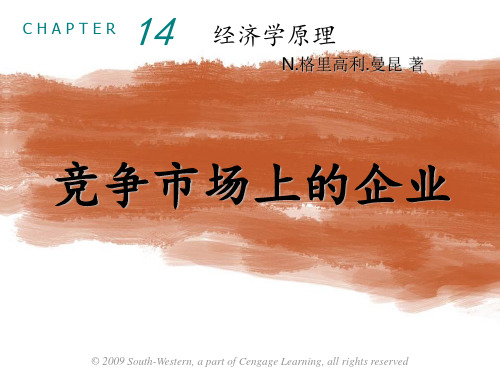
4
作为这些特点的结果,完全竞争市场有以下结果: 1、市场上有许多小的卖者, 也有许多小的买者,没有一
个买者能对价格施加大的影响。 2、每一个买者和卖者都把市场价格作为既定 竞争市场上的买者和卖者被称为价格接受者 。 买者和卖者必须接受市场决定的价格。
精品文档 经济学基础
么关系? 竞争企业如何决定利润最大化的产量? 短期内,竞争企业何时会选择停业?长期内,
竞争企业何时会选择退出市场? 短期的市场供给曲线是什么形状?长期的呢?
精品文档 经济学基础
一、什么是竞争市场
3
1、竞争的含义 完全竞争市场或竞争市场:有许多交易相同产品的买者与
卖者,一直与每一个买者和卖者都是价格接受者的市场 特点: 1、市场上有许多买者和卖者 2、各个卖者提供的物品大体上相同 3、企业可以自由进入或退出市场
14 C H A P T E R
经济学原理
N.格里高利.曼昆 著
竞争市场上的企业
© 2009 South-Western, a part of Cengage Learning, all rights reserved
本章我们将探索这些问题的答案:
2
什么是完全竞争市场? 什么是边际收益?它和总收益与平均收益有什
收益 平均收益(average revenue)告诉我们企业从销售的普
通一单位中得到了多少收益。 竞争市场中,对所有企业来说,平均收益等于价格。 平均收益 AR = TR/Q = (P×Q)/Q =P
精品文档 经济学基础
8
边际收益Marginal revenue :增加一单位销售量引起的 总收益变化
Q1
Q2
精品文档
数量
20
《经济学原理曼昆》PPT课件

精选ppt
18
例 4:汽油需求:——短期 抑或 长期?
( Gasoline in the Short Run vs. Gasoline in the Long Run )
▪ 假如汽油价格上涨20%,在短期 或 长期,哪种情形下汽油需求量会下
降更多?为什么?
▪ 短期:汽油需求下降不太明显
—— 因为,短期人们除了尽可能乘坐公交车之外,没有太多其他替 代方法
( Q2 – Q1 ) / Q1 需求价格弹性 = ——————————
( P2 – P1 ) / P1
精选ppt
11
利用“中点法”计算需求弹性
▪ 利用上述例子,采用“中点法”计算弹性,无论把哪一点(A或B)作
为变化的初始值或终止值,计算的弹性结果均相同:
▪ 价格变动的百分比:
= (250 – 200)/(250+200)/2 =50/225 =22.2%
供一个初略的答案:
—— 例如,消费者会因价格上涨减少对该物品的购买,即表现为需求量下
降
▪ 但要准确回答需求量究竟减少多少,则需借助其
他理论
▪ 这个理论就是“弹性理论”
精选ppt
2
举例( A Story):
假如你的工作是为本地企业制作网站,制作一个网站收费 200美元。目前你每个月能卖出12个网站 由于制作网站的成本上升(包括你的时间的机会成本), 因此,你考虑把价格由原先的$200提升到$250 需求定理告诉我们:如提高价格,你就不能卖出原来那么 多的网站 你将少卖出多少网站?你的收益将会增加还是减少?增加 或减少多少?
精选ppt
15
例1:“加勒比” 游艇 vs. 胰岛素:
——必需品 vs. 奢侈品?( Caribbean Cruises vs. Insulin )
经济学原理曼昆PPT课件

▪ 生产可能性边界与机会成本有什么联系?它还表示了什么其他概念? ▪ How is the Production Possibilities Frontier related
to opportunity cost? What other concepts does it illustrate?
15
主动学习 1
不在生产可能性边界上的点
A.在图上找出代表100台电脑和3000吨小麦的点, 并标作F。问:经济能生产出这样的两种产品数 量组合吗?为什么?
B. 找出代表300台电脑和3500吨小麦的点,并标作 G。问:经济能生产出这样的两种产品组合吗? 为什么?
16
主动学习 1
参考答案
▪ F点:代表100台电
The Circular-Flow Diagram
经济学的第一个模型:循环流量图
▪ The Circular-Flow Diagram :a visual model of the economy, shows how dollars
flow through markets among households and firms
5
Some Familiar Models(熟悉的模型)
飞机模型 A model airplane
6
Some Familiar Models(熟悉的模型)
牙医办公室里的牙齿模型
The model teeth at the dentist’s office
不要忘了刷 牙!
7
The First Model:
▪ 微观和宏观经济学,实证的和规范的经济学有何不同? ▪ What is the difference between microeconomics and
经济学原理ppt课件曼昆

和稳定全球经济。
汇率制度
固定汇率制度
固定汇率制度是指各国货币之 间保持相对稳定的汇率,通常
由中央银行进行干预。
浮动汇率制度
浮动汇率制度是指汇率由市场 供求关系决定,中央银行不进 行干预。
汇率目标区
汇率目标区是指各国政府设定 的汇率波动区间,以减少货币 投机的可能性。
货币局制度
货币局制度是指政府将本国货 币与另一国货币或一篮子货币 挂钩,通过固定汇率制度实现
货币稳定。
全球化与经济发展
全球化对经济增长的影响
技术进步与经济发展
全球化通过促进国际贸易和投资流动,有 助于提高生产效率和促进经济增长。
技术进步是推动经济发展的重要因素之一 ,它能够提高生产效率和产品质量,创造 新的市场需求。
量。
市场结构
完全竞争市场
市场中存在大量的小规模生产者,每个 生产者对市场价格的影响微乎其微。
垄断市场
只有一个生产者提供产品,其他生产者 无法进入市场。
寡头市场
少数几家生产者占据大部分市场份额, 产品具有同质性。
垄断竞争市场
市场中存在大量生产者,产品具有差异 性。
价格与市场均衡
03
价格接受者
价格制定者
企业竞争策略与产业组织
企业竞争策略
01
企业为了在市场竞争中获得优势,会采取各种竞争策略,例如
价格战、品牌建设等。
产业组织
02
产业组织是指同一产业内企业之间的组织结构和关系,对于企
业竞争策略和产业绩效具有重要影响。
总结
03
企业竞争策略与产业组织是经济学中研究的重要领域,对于理
曼昆经济学原理课后答案第十四章竞争市场上的企业
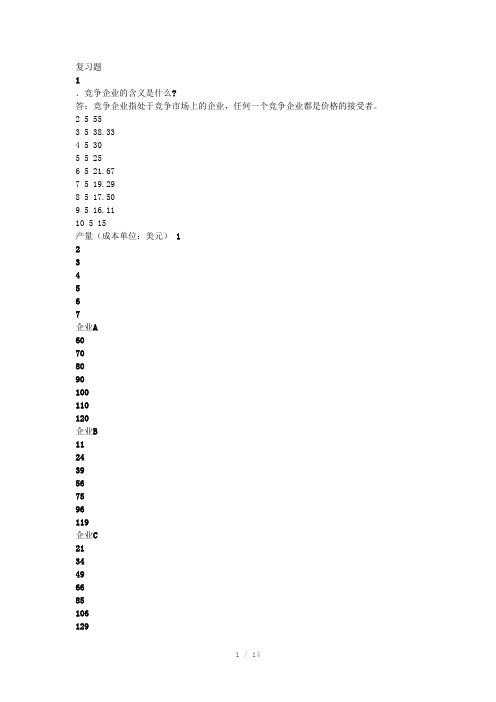
复习题1.竞争企业的含义是什么?答:竞争企业指处于竞争市场上的企业,任何一个竞争企业都是价格的接受者。
2 5 553 5 38.334 5 305 5 256 5 21.677 5 19.298 5 17.509 5 16.1110 5 15产量(成本单位:美元)1234567企业A60708090100110120企业B112439567596119企业C2134496685106129产量(成本单位:美元) 1 2 3 4 5 6 7企业A 60 35 27 22.5 20 18 17企业B 11 12 13 14 15 16 17企业C 21 17 16 16.5 17 18 18.4812.解释企业收益与企业利润的差别。
企业使什么最大化?答:企业的总收益等于单位销售数量乘以其价格,即企业销售其产品所得到的货币量。
企业利润是总收益和总成本的差额。
企业使利润最大化。
3.画出一个典型企业的成本曲线。
解释在某一既定价格时,企业应如何选择利润最大化的产量水平。
在该产量水平时,在你的图形中标明企业的总收益及总成本答:竞争企业在某一既定价格时,利润最大化的产量水平Q 是在边际成本曲线和价格水平曲线的相交之处。
因为如果企业选择产量Q1,Q1<Q,MC<MR,即企业增加一单位产量所带来的边际收益大于边际成本。
于是,企业会增加产量以提高利润。
如果企业选择产量Q2(Q2>Q),MC>MR,即企业再增加一单位产量所带来的边际收益小于边际成本。
于是,企业可以通过减少产量以提高利润。
图14-1 典型企业的成本曲线4.在什么条件下企业将暂停营业?解释原因。
答:如果物品的价格低于生产的平均成本,企业选择停止营业。
在短期内,固定成本是沉没成本,在此决策中不考虑。
作出这一决策的原因很简单:在选择生产时,企业比较普通一单位产量所得到的价格与生产这一单位必定引起的平均可变成本。
如果价格没有弥补平均可变成本,企业停止生产,状况会变好一些。
微观经济学-曼昆版 PPT10

当政策制定者不知道需求曲线的位置时, 这种许可证制度能更好的达到减少污染的 目标
15
对关于污染的经济分析的批评
一些政客以及许多环保主义者宣称:没有人拥 有“购买”污染的权利,也不能对环境标价
然而,人们面临权衡取舍。清新的空气与清 洁的水的价值必须与它们的 Nhomakorabea本进行比较
6
外部性的影响:总结
如果存在负外部性 市场生产的数量大于社会合意的数量 如果存在正外部性 市场生产的数量小于社会合意的数量 为了解决这个问题,可以使“外部性内在化” 对有负外部性的物品征税 对有正外部性的物品补贴
7
两种方法针:对外部性的公共政策
命令与控制政策:直接管制
例如:
限制排放的污染数量 强制企业采取某种技术来减少排放量
当市场参与者必须支付社会成本时, 市场均衡= 社会均衡
(对买者征税也能达到相同的结果;市场均衡 量等于社会最优量)
4
接种预防传正染外病的部疫性苗的不例子
仅保护你自己,而且也保 护在你之后到沙拉吧或者 生产部门的人.
研究与发展创造出了别人 也可以使用的知识
人们上大学提高了教育水 平,并减少了犯罪和改善 了政府
以市场为基础的政策:向私人决策者提供 由他们自己来解决问题的激励。
例如:
矫正性税收与补贴
可交易的污染许可证
8
矫正税:矫旨在正引性导税私人收决与策补者考贴虑负外部性
引起的社会成本的税收 这种税也被称为庇古税,它是以最早主张采
用这种税收的经济学家阿瑟·庇古(Arthur Pigou,1877-1959)的名字命名的 理想的矫正税= 外部成本 对于有正外部性的活动,理想的矫正补贴= 外部利益
曼昆《经济学原理》(微观)第五版测试题库(14)(1)
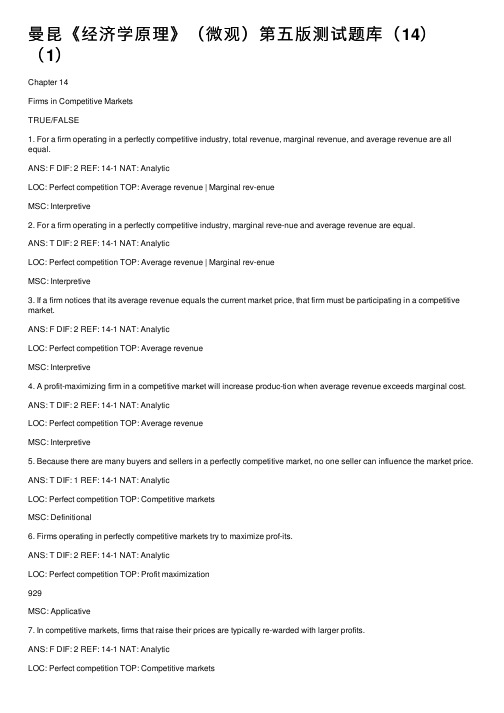
曼昆《经济学原理》(微观)第五版测试题库(14)(1)Chapter 14Firms in Competitive MarketsTRUE/FALSE1. For a firm operating in a perfectly competitive industry, total revenue, marginal revenue, and average revenue are all equal.ANS: F DIF: 2 REF: 14-1 NAT: AnalyticLOC: Perfect competition TOP: Average revenue | Marginal rev-enueMSC: Interpretive2. For a firm operating in a perfectly competitive industry, marginal reve-nue and average revenue are equal.ANS: T DIF: 2 REF: 14-1 NAT: AnalyticLOC: Perfect competition TOP: Average revenue | Marginal rev-enueMSC: Interpretive3. If a firm notices that its average revenue equals the current market price, that firm must be participating in a competitive market.ANS: F DIF: 2 REF: 14-1 NAT: AnalyticLOC: Perfect competition TOP: Average revenueMSC: Interpretive4. A profit-maximizing firm in a competitive market will increase produc-tion when average revenue exceeds marginal cost. ANS: T DIF: 2 REF: 14-1 NAT: AnalyticLOC: Perfect competition TOP: Average revenueMSC: Interpretive5. Because there are many buyers and sellers in a perfectly competitive market, no one seller can influence the market price. ANS: T DIF: 1 REF: 14-1 NAT: AnalyticLOC: Perfect competition TOP: Competitive marketsMSC: Definitional6. Firms operating in perfectly competitive markets try to maximize prof-its.ANS: T DIF: 2 REF: 14-1 NAT: AnalyticLOC: Perfect competition TOP: Profit maximization929MSC: Applicative7. In competitive markets, firms that raise their prices are typically re-warded with larger profits.ANS: F DIF: 2 REF: 14-1 NAT: AnalyticLOC: Perfect competition TOP: Competitive marketsMSC: Interpretive8. When an individual firm in a competitive market increases its produc-tion, it is likely that the market price will fall. ANS: F DIF: 2 REF: 14-1 NAT: AnalyticLOC: Perfect competition TOP: Competitive marketsMSC: Interpretive9. In a competitive market, firms are unable to differentiate their product from that of other producers.ANS: T DIF: 1 REF: 14-1 NAT: AnalyticLOC: Perfect competition TOP: Competitive marketsMSC: Interpretive10. Firms in a competitive market are said to be price takers because there are many sellers in the market and the goods offered by the firms are very similar if not identical.ANS: T DIF: 2 REF: 14-1 NAT: AnalyticLOC: Perfect competition TOP: Competitive marketsMSC: Interpretive11. A firm's incentive to compare marginal revenue and marginal cost is an application of the principle that rational people think at the margin. ANS: T DIF: 1 REF: 14-2 NAT: AnalyticLOC: Perfect competition TOP: Profit maximizationMSC: Interpretive12. By comparing the marginal revenue and marginal cost from each unit produced, a firm in a competitive market can determine the profit-maximizing level of production.ANS: T DIF: 2 REF: 14-2 NAT: AnalyticLOC: Perfect competition TOP: Profit maximizationMSC: Interpretiveword⽂档可⾃由复制编辑Chapter 14/Firms in Competitive Markets 931 13. Firms operating in perfectly competitive markets produce an output level where marginal revenue equals marginal cost.ANS: T DIF: 2 REF: 14-2 NAT: AnalyticLOC: Perfect competition TOP: Marginal revenueMSC: Applicative14. A firm is currently producing 100 units of output per day. The man-ager reports to the owner that producing the 100th unit costs the firm $5. The firm can sell the 100th unit for $4.75. The firm should continue to pro-duce 100 units in order to maximize its profits (or minimize its losses). ANS: F DIF: 2 REF: 14-2 NAT: AnalyticLOC: Perfect competition TOP: Profit maximizationMSC: Analytical15. A firm is currently producing 100 units of output per day. The man-ager reports to the owner that producing the 100th unit costs the firm $5. The firm can sell the 100th unit for $5. The firm should continue to produce 100 units in order to maximize its profits (or minimize its losses).ANS: T DIF: 2 REF: 14-2 NAT: AnalyticLOC: Perfect competition TOP: Profit maximizationMSC: Analytical16. A firm is currently producing 100 units of output per day. The man-ager reports to the owner that producing the 100th unit costs the firm $5. The firm can sell the unit for $6. The firm should produce more than 100 units in order to maximize its profits (or minimize its losses).ANS: T DIF: 2 REF: 14-2 NAT: AnalyticLOC: Perfect competition TOP: Profit maximizationMSC: Analytical17. A dairy farmer must be able to calculate sunk costs in order to deter-mine how much revenue the farm receives for the typical gallon of milk. ANS: F DIF: 1 REF: 14-2 NAT: AnalyticLOC: Perfect competition TOP: Sunk costs MSC: I nterpretive18. Because nothing can be done about sunk costs, they are irrelevant to decisions about business strategy.ANS: T DIF: 2 REF: 14-2 NAT: AnalyticLOC: Perfect competition TOP: Sunk costs MSC: I nterpretive19. A miniature golf course is a good example of where fixed costs be-come relevant to the decision of when to open and when to close for the season.ANS: F DIF: 2 REF: 14-2 NAT: AnalyticLOC: Perfect competition TOP: Sunk costs MSC: I nterpretive20. A popular resort restaurant will maximize profits if it chooses to stay open during the less-crowded “off season” when its total revenues exceed its variable costs.ANS: T DIF: 2 REF: 14-2 NAT: AnalyticLOC: Perfect competition TOP: Sunk costs MSC: I nterpretive21. All firms maximize profits by producing an output level where marginal revenue equals marginal cost; for firms operating in perfectly competitive in-dustries, maximizing profits also means producing an output level where price equals marginal cost.ANS: T DIF: 2 REF: 14-2 NAT: AnalyticLOC: Perfect competition TOP: Profit maximizationMSC: Interpretive22. A firm operating in a perfectly competitive industry will continue to op-erate in the short run but earn losses if the market price is less than that firm’s average total cost but greater than the firm’s average variable cost. ANS: T DIF: 2 REF: 14-2 NAT: AnalyticLOC: Perfect competition TOP: Supply curveMSC: Interpretive23. A firm operating in a perfectly competitive industry will continue to op-erate in the short run but earn losses if the market price is less than that firm’s average variable co st.ANS: F DIF: 2 REF: 14-2 NAT: AnalyticLOC: Perfect competition TOP: Supply curveMSC: Interpretive24. A firm operating in a perfectly competitive industry will shut down in the short run but earn losses if the market price is less than that firm’s aver-age variable cost.ANS: T DIF: 2 REF: 14-2 NAT: AnalyticLOC: Perfect competition TOP: Supply curveMSC: Interpretiveword⽂档可⾃由复制编辑Chapter 14/Firms in Competitive Markets 933 25. In the short run, a firm should exit the industry if its marginal cost ex-ceeds its marginal revenue.ANS: F DIF: 2 REF: 14-2 NAT: AnalyticLOC: Perfect competition TOP: Supply curveMSC: Interpretive26. In making a short-run profit-maximizing production decision, the firm must consider both fixed and variable cost. ANS: F DIF: 2 REF: 14-2 NAT: AnalyticLOC: Perfect competition TOP: Profit maximizationMSC: Interpretive27. A firm will shut down in the short run if revenue is not sufficient to cov-er its variable costs of production.ANS: T DIF: 2 REF: 14-2 NAT: AnalyticLOC: Perfect competition TOP: Shut down MSC: I nterpretive28. Suppose a firm is considering producing zero units of output. We call this shutting down in the short run and exiting an industry in the long run. ANS: T DIF: 2 REF: 14-2 NAT: AnalyticLOC: Perfect competition TOP: Shut down MSC: I nterpretive29. Suppose a firm is considering producing zero units of output. We call this exiting an industry in the short run and shutting down in the long run. ANS: F DIF: 2 REF: 14-2 NAT: AnalyticLOC: Perfect competition TOP: Shut down MSC: I nterpretive30. A firm will shut down in the short run if revenue is not sufficient to cov-er all of its fixed costs of production.ANS: F DIF: 2 REF: 14-2 NAT: AnalyticLOC: Perfect competition TOP: Shut down MSC: I nterpretive31. The supply curve of a firm in a competitive market is the average va-riable cost curve above the minimum of marginal cost.ANS: F DIF: 2 REF: 14-2 NAT: AnalyticLOC: Perfect competition TOP: Supply curveMSC: Interpretive32. When a profit-maximizing firm in a competitive market experiences rising prices, it will respond with an increase in production.ANS: T DIF: 2 REF: 14-2 NAT: AnalyticLOC: Perfect competition TOP: Profit maximizationMSC: Interpretive33. The marginal firm in a competitive market will earn zero economic profit in the long run.ANS: T DIF: 2 REF: 14-2 NAT: AnalyticLOC: Perfect competition TOP: Economic profitMSC: Interpretive34. A profit-maximizing firm in a competitive market will earn zero ac-counting profits in the long run.ANS: F DIF: 2 REF: 14-2 NAT: AnalyticLOC: Perfect competition TOP: Accounting profitMSC: Interpretive35. In the long run, when price is less than average total cost for all possi-ble levels of production, a firm in a competitive market will choose to exit (or not enter) the market.ANS: T DIF: 2 REF: 14-2 NAT: AnalyticLOC: Perfect competition TOP: Profit maximizationMSC: Interpretive36. In the long run, when price is greater than average total cost, some firms in a competitive market will choose to enter the market.ANS: T DIF: 2 REF: 14-2 NAT: AnalyticLOC: Perfect competition TOP: Profit maximizationMSC: Interpretive37. In the long run, a firm should exit the industry if its total costs exceed its total revenues.ANS: T DIF: 2 REF: 14-2 NAT: AnalyticLOC: Perfect competition TOP: Profit maximizationMSC: Interpretive38. When a resource used in the production of a good sold in a competi-tive market is available in only limited quantities, the long-run supply curve is likely to be upward sloping.ANS: T DIF: 2 REF: 14-3 NAT: AnalyticLOC: Perfect competition TOP: Supply curveMSC: Interpretiveword⽂档可⾃由复制编辑Chapter 14/Firms in Competitive Markets 935 39. A firm operating in a perfectly competitive industry will continue to op-erate if it earns zero economic profits because it is likely to be earning posi-tive accounting profits.ANS: T DIF: 2 REF: 14-3 NAT: AnalyticLOC: Perfect competition TOP: Competitive marketsMSC: Interpretive40. A firm operating in a perfectly competitive industry will shut down in the short run if its economic profits fall to zero because it is likely to be earn-ing negative accounting profits.ANS: F DIF: 2 REF: 14-3 NAT: AnalyticLOC: Perfect competition TOP: Competitive marketsMSC: Interpretive41. A firm operating in a perfectly competitive market may earn positive, negative, or zero economic profit in the long run. ANS: F DIF: 2 REF: 14-3 NAT: AnalyticLOC: Perfect competition TOP: Long-run supply curveMSC: Interpretive42. A firm operating in a perfectly competitive market may earn positive, negative, or zero economic profit in the short run. ANS: T DIF: 2 REF: 14-3 NAT: AnalyticLOC: Perfect competition TOP: Long-run supply curveMSC: Interpretive43. A firm operating in a perfectly competitive market earns zero economic profit in the long run but remains in business because the firm’s revenues cover the business owners’ opportunity costs.ANS: T DIF: 2 REF: 14-3 NAT: AnalyticLOC: Perfect competition TOP: Zero-profit conditionMSC: Interpretive44. A competitive market will typically experience entry and exit until ac-counting profits are zero.ANS: F DIF: 2 REF: 14-3 NAT: AnalyticLOC: Perfect competition TOP: Zero-profit conditionMSC: Interpretive45. The long-run equilibrium in a competitive market characterized by firms with identical costs is generally characterized by firms operating at effi-cient scale.ANS: T DIF: 2 REF: 14-3 NAT: AnalyticLOC: Perfect competition TOP: Zero-profit conditionMSC: Interpretive46. In the long run, a competitive market with 1,000 identical firms will ex-perience an equilibrium price equal to the minimum of each firm's average total cost.ANS: T DIF: 2 REF: 14-3 NAT: AnalyticLOC: Perfect competition TOP: Zero-profit conditionMSC: Interpretive47. In a long-run equilibrium where firms have identical costs, it is possible that some firms in a competitive market are making a positive economic prof-it.ANS: F DIF: 2 REF: 14-3 NAT: AnalyticLOC: Perfect competition TOP: Zero-profit conditionMSC: Interpretive48. When economic profits are zero in equilibrium, the firm's revenue must be sufficient to cover all opportunity costs. ANS: T DIF: 2 REF: 14-3 NAT: AnalyticLOC: Perfect competition TOP: Zero-profit conditionMSC: Interpretive49. The short-run supply curve in a competitive market must be more elastic than the long-run supply curve.ANS: F DIF: 2 REF: 14-3 NAT: AnalyticLOC: Perfect competition TOP: Supply curveMSC: Interpretive50. The long-run supply curve in a competitive market is more elastic than the short-run supply curve.ANS: T DIF: 2 REF: 14-3 NAT: AnalyticLOC: Perfect competition TOP: Supply curveMSC: InterpretiveSHORT ANSWERword⽂档可⾃由复制编辑Chapter 14/Firms in Competitive Markets 937 1. Describe the difference between average revenue and marginal reve-nue. Why are both of these revenue measures important to a prof-it-maximizing firm?ANS:Average revenue is total revenue divided by the quantity of output. Marginal revenue is the change in total revenue from the sale of each additional unit of output. Marginal revenue is used to determine the profit-maximizing level of production, and average revenue is used to help determine the level of profits. Note that for all firms, price equals average revenue because AR=(PxQ)/Q=P. But only for a firm operating in a perfectly competitive industry does price al-so equal marginal revenue.DIF: 2 REF: 14-1 NAT: Analytic LOC: Perfect competitionTOP: Price MSC: D efinitional2. List and describe the characteristics of a perfectly competitive market. ANS:There are many buyers and sellers in the market. The goods offered by the various sellers are largely the same. Firms can freely enter or exit the market. DIF: 2 REF: 14-1 NAT: Analytic LOC: Perfect competitionTOP: Competitive markets MSC: D efinitional3. Why would a firm in a perfectly competitive market always choose to set its price equal to the current market price? If a firm set its price below the current market price, what effect would this have on the market?ANS:The firm could not sell any more of its product at a lower price than it could sell at the market price. As a result, it would needlessly forgo revenue if it set a price below the market price. If the firm set a higher price, it would not sell anything at all because a competitive market has many sellers who would supply the product at the market price.DIF: 2 REF: 14-1 NAT: Analytic LOC: Perfect competitionTOP: Profit maximization MSC: A nalytical4. Use a graph to demonstrate the circumstances that would prevail in a competitive market where firms are earning economic profits. Can this sce-nario be maintained in the long run? Explain your answer.ANS:In a competitive market where firms are earning economic profits, new firms will have an incentive to enter the market. This entry will expand the number of firms, increase the quantity of the good supplied, and drive down pricesword ⽂档可⾃由复制编辑 and profits. Entry will cease once firms are producing the output level where price equals the minimum of the average total cost curve, meaning that eachfirm earns zero economic profits in the long run.DIF: 2 REF: 14-2 NAT: AnalyticLOC: Perfect competition TOP: Profit maximization MSC: A nalytical5. Explain how a firm in a competitive market identifies the prof-it-maximizing level of production. When should the firm raise production, and when should the firm lower production? ANS:The firm selects the level of output at which marginal revenue is equal tomarginal cost. If MR > MC, profit will increase if the firm increases Q. If MR < MC, profit will increase if the firm decreases Q. DIF: 2 REF: 14-2 NAT: AnalyticLOC: Perfect competition TOP: Profit maximization MSC: A nalytical6. News reports from the western United States occasionally report inci-dents of cattle ranchers slaughtering a large number of newborn calves and burying them in mass graves rather than transporting them to markets. As-suming that this is rational behavior by profit-maximizing "firms," explain what economic factors may influence such behavior.ANS:If the selling price is not sufficient to cover the variable cost of sending the calves to market, this (potentially emotionally upsetting) behavior makes economic sense.DIF: 2 REF: 14-2 NAT: AnalyticLOC: Perfect competition TOP: Profit maximization MSC: A nalytical。
微观经济学第14章课件

都只想搭便车(使用极端正外部性)而不付费。 于是,市场失灵,需要政府干预。
公共物品:非排他非竞争
公共物品的最优数量
由个人需求曲线到市场需求曲线区别:
私人物品是水平(数量Q)相加; 公共物品是垂直(价格P)相加。
(因非排他非竞争)
公共物品与市场失灵
易“免费乘车”致生产不足
即政府可集中计划生产并根据社会福利原则来 分配公共物品。
什么是外部性
外部性及类别
1、外部性(又称外在效应或溢出效应):没有 在市场交易中反映出来的一个经济主体对其他 经济主体的外在影响。
2、社会成本=私人成本+外部成本 3、社会利益=私人利益+外部利益 4、负外部性:私人成本<社会成本 5、正外部性:私人利益<社会利益
纠正外部影响(纠正市场失灵的办法) ?
故市场机制(谈判交易)不必政府而有效配置资源。
1、若受害者握产权,则从原点开始,有向Qe移动的自然趋势。 2、若排污者握产权,则从Qm开始,……?
成本
或
效益
边际私人 净效益
外部成本
h
g
a
b
c Od
Qe 最优点
f
e Qm 经济活 动水平Q
故应“创新”。
科斯定理运用难题:
产权明晰问题; 产权转让问题; 效果实现问题; 分配影响问题。
私人物品。不必政府操心。
2、公共物品:是具有消费的非排他性和非竞争
性,不能依靠市场交易实现有效配置的产品。
非排他非竞争如国防、灯塔、无线电视、环保等。 公共物品因其非排他性──或在技术上不能排他、
或排他成本很高而不可实施, 导致“搭便车”或称“免费搭车”。
如流域范围无法用市场机制自发修水坝。 又如1970年美通用汽车向市场推出汽车污染物排放
曼昆经济学原理第5版微观经济学精品PPT课件

▪ 在许多情况下,价格引导自利的家庭与企业做
出使社会经济福利最大化的决策
人们如何相互交易
原理 7: 政府有时可以改善市场结果
▪ 政府的重要作用: 保护产权 (通过警察,法庭) ▪ 如果人们的财产存在很大的被侵犯的风险,那么他
们便不愿意工作,生产,投资或者购买物品
人们如何相互交易
间学习
▪ 想要更多的收入需要工作更长时间,这就使得休
息时间减少
▪ 保护环境意味着生产消费物品的资源减少
人们如何做出决策
原理 1: 人们面临权衡取舍
▪ 社会面临一种重要的权衡取舍:
效率 vs. 平等
▪ 效率: 社会能从其稀缺资源中得到的最大利益 ▪ 平等: 经济成果在社会成员中平均分配 ▪ 权衡取舍:为使社会更加平等, 需要在富人与穷人
在下面的情形中,你应该把变速器修好吗?并解 释
A. 如果变速器正常,汽车价值是$6500 。如果不 正常,则是$5700
B. 如果变速器正常,汽车价值是$6000 。如果不 正常,则是$5500
11
主动学习 1
参考答案
修理变速器的成本= $600
A. 如果变速器正常,汽车价值是$6500 。如果不正 常,则是$5700
▪ 人们决定购买什么, 工作多长时间,储蓄多少,
消费多少
▪ 企业决定生产多少,雇佣多少工人 ▪ 社会决定如何在国防,消费物品,环境保护和其
他需求之间分配资源
人们如何 做出决策
人们如何做出决策
原理 1: 人们面临权衡取舍
所有决策都面临着权衡取舍。比如:
▪ 参加期中考试前一天晚上的聚会意味着更少的时
人们如何相互交易
原理 6:市场通常是组织经济活动的一种好方法
(2024年)曼昆经济学原理第五版宏观全ppt课件

03
货币市场与利率决定
2024/3/26
12
货币市场概述及工具
01
货币市场定义
货币市场是短期资金供求的场所, 主要交易一年以内的短期金融工
具。
2024/3/26
02
货币市场工具
03
货币市场功能
包括商业票据、银行承兑汇票、 大额可转让定期存单、回购协议
等。
提供短期资金融通、管理流动性、 发现短期资金价格等。
总供给
总供给减少会导致价格水平上升。
预期
预期通货膨胀率上升会导致价格水平上升。
2024/3/26
19
价格水平决定因素及模型
货币数量论
MV=PY,其中M为货币供应量,V为货币流 通速度,P为价格水平,Y为实际产出。该模 型认为价格水平由货币供应量和实际产出决 定。
2024/3/26
总供给-总需求模型
2024/3/26
27
国际金融理论与政策实践
国际金融理论
包括汇率决定理论、国际收支理论等,解释国 际金融市场的运行和汇率波动的原因。
2024/3/26
国际金融政策工具
包括汇率政策、国际储备政策、国际金融机构等,分 析其对国际金融稳定和发展的作用。
国际金融危机与应对
探讨国际金融危机的成因、传导机制和应对措 施,以及国际合作在危机应对中的重要性。
结构类型
根据劳动力供求双方的特点和交易方式,劳动市场可分为完 全竞争市场、买方垄断市场、卖方垄断市场和双边垄断市场 四种类型。
2024/3/26
23
工资水平决定因素及模型
决定因素
工资水平受多种因素影响,包括劳动力供求关系、劳动生 产率、经济发展水平、行业差异、地区差异等。
曼昆经济学原理(微观部分)-经济学十大原理课件
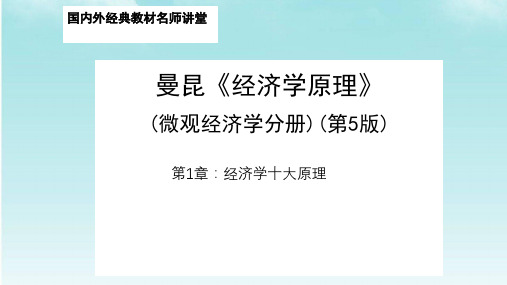
原理1: 人们面临着交替关系
People Face Tradeoffs. 天下没有免费的午餐!
“There is no such thing as a free lunch!”
曼昆经济学原理(微观部分)-经济学十大原理
原理1: 人们面临着交替关系
People Face Tradeoffs.
曼昆经济学原理(微观部分)-经济学十大原理
原理8: 生活水平取决于一国的生 产
• Almost all variations in living standards are explained by differences in countries’ productivities.
• 生活水平的几乎所有差异都可以用各个国家生产率 的差异加以解释。
• an externality, which is the impact of one person or firm’s
actions on the well-being of a bystander. • 外部性---一个人或企业的行为对局外人福利的影响。
• market power, which is the ability of a single person or
是你为
曼昆经济学原理(微观部分)-经济学十大原理
原理2:某一事物的成本是你为了 获得它而放弃的东西
LA Laker 的篮球明星 Kobe Bryant 选择放弃上大学,从高 中直接进入职业球队,因此他 可以赚到成百上千万美元。
曼昆经济学原理(微观部分)-经济学十大原理
原理3: 理性人进行边际思考
resources through the decentralized decisions of many firms and households as they interact in markets for goods and services.市场经济是一种通 过许多企业和家庭的分散决策配置资源的经济,与 此同时企业和家庭在商品和服务市场上发生相互作 用。
曼昆经济学原理第5版微观PPT全
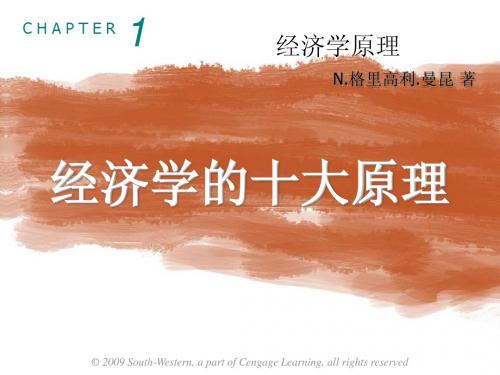
“看不见的手”通过价格体系来发挥作用: 买者与卖者之间的相互作用决定市场价格 每个价格即反映了物品对于买者的价值,也反
映了生产物品的成本
在许多情况下,价格引导自利的家庭与企业做
出使社会经济福利最大化的决策
经济学十大原理
19
人们如何相互交易
原理 7 :政府有时可以改善市场结果
政府的重要作用: 保护产权 (通过警察,法庭)
25
整体经济如何运行
原理 8 :一国的生活水平取决于它生产物品与 劳务的能力
决定生活水平的最重要因素:生产率,即每一单位劳
动投入所生产的物品与劳务数量
生产率取决于设备,劳动者的技能以及可用的技术 其它因素(比如,工会组织,国外的竞争)对于生活
水平的影响远远小于生产率
经济学十大原理
26
整体经济如何运行
像经济学家一样思考
47
经济学十大原理
16
人们如何相互交易
原理 6 :市场通常是组织经济活动的一种好方法
市场: 大量的买者与卖者
(不必要在同一个地点)
组织经济活动意味着需要决定 生产什么 怎么生产 生产多少 谁将得到它们
经济学十大原理
17
人们如何相互交易
原理 6 :市场通常是组织经济活动的一种好方法
在下面的情形中,你应该把变速器修好吗?并解释 A. 如果变速器正常,汽车价值是$6500 。如果不 正常,则是$5700 B. 如果变速器正常,汽车价值是$6000 。如果不 正常,则是$5500
12
主动学习
1
参考答案
修理变速器的成本= $600
A. 如果变速器正常,汽车价值是$6500 。如果不正 常,则是$5700
曼昆经济学原理第5版宏观PPT全

例:
年份 2005 2006 2007 名义 GDP $6000 $8250 $10,800
37.5% 30.9%
真实 GDP $6000 $7200 $8400
20.0% 16.7%
• 名义GDP的变化反映了价格与产量的变化
真实GDP的变化是价格不变时(就是零通货膨胀
条件),GDP数量的变化
2007
$12
600
$3.00
1200
计算每年的名义GDP:
2005: 2006: 2007:
一国收入的衡量
增加: = $6,000 = $8,250 = $10,800 37.5% 30.9%
$10 x 400 + $2 x 1000 $11 x 500 + $2.50 x 1100 $12 x 600 + $3 x 1200
14.6% 12.2%
2007
$10,800
$8400
计算每年的GDP 平减指数:
2005: 2006: 2007:
一国收入的衡量
100 x (6000/6000) = 100 x (8250/7200) = 100 x (10,800/8400) =
31
100.0 114.6 128.6
主动学习
29
真实GDP(基
年是2000年)
名义GDP
GDP平减指数
• GDP平减指数是对总体价格水平的衡量 • 定义:
GDP平减指数= 100 x
名义 GDP 真实 GDP
衡量经济通货膨胀率的一种方法是计算从一年到
下一年GDP平减指数增加的百分比
一国收入的衡量
30
例:
(微观 宏观全)曼昆《经济学原理》(第五版)课后习题答案-中文版

曼昆《经济学原理》(第五版)习题解答目录第一章经济学十大原理 (1)第二章像经济学家一样思考 (7)第三章相互依存性与贸易的好处 (14)第四章供给与需求的市场力量 (22)第五章弹性及其应用 (31)第六章供给、需求与政府政策 (41)第七章消费者、生产者与市场效率 (50)第八章应用:赋税的代价 (58)第九章应用:国际贸易 (65)第十章外部性 (75)第十一章公共物品和公共资源 (84)第十二章税制的设计 (91)第十三章生产成本 (99)第十四章竞争市场上的企业 (109)第十五章垄断 (121)第十六章垄断竞争 (135)第十七章寡头 (143)第十八章生产要素市场 (153)第十九章收入与歧视 (162)第二十章收入不平等与贫困 (169)第二十一章消费者选择理论 (177)第二十二章微观经济学前沿 (187)第二十三章一国收入的衡量 (195)第二十四章生活费用的衡量 (204)第二十五章生产与增长 (210)第二十六章储蓄、投资和金融体系 (214)第二十七章基本金融工具 (221)第二十八章失业 (226)第一篇导言第一章经济学十大原理复习题1.列举三个你在生活中面临的重要权衡取舍的例子。
答:①大学毕业后,面临着是否继续深造的选择,选择继续上学攻读研究生学位,就意味着在今后三年中放弃参加工作、赚工资和积累社会经验的机会;②在学习内容上也面临着很重要的权衡取舍,如果学习《经济学》,就要减少学习英语或其他专业课的时间;③对于不多的生活费的分配同样面临权衡取舍,要多买书,就要减少在吃饭、买衣服等其他方面的开支。
2.看一场电影的机会成本是什么?答:看一场电影的机会成本是在看电影的时间里做其他事情所能获得的最大收益,例如:看书、打零工。
3.水是生活必需的。
一杯水的边际利益是大还是小呢?答:这要看这杯水是在什么样的情况下喝,如果这是一个人五分钟内喝下的第五杯水,那么他的边际利益很小,有可能为负;如果这是一个极度干渴的人喝下的第一杯水,那么他的边际利益将会极大。
曼昆经济学原理第5版微观第十四章PPT课件

如果飞行一次的成本为2万美元,其中固定成本为1万美元,可 变成本为1万美元,只要机票为250美元,乘客大于(或等于) 40人就可以飞行下去。如果乘客为40人,运送每位乘客的平均 可变成本为250元,票价为250美元,这时就是停止营业点。
结论:当企业在经营状况不良(飞机乘客不足)时是否停止关 键在于可变成本,而可以不考虑固定成本。
新企业进入市场的决策
▪ 长期内,如果 TR > TC,一个新企业将进入市场 ▪ 企业的进入决策两边除以Q :
如果 P > ATC,进入市场
.FIRMS IN COMPETITIVE MARKETS
23
竞争企业的供给曲线
竞争企业的长期
供给曲线是边际
成本
成本曲线位于长
期平均总成本曲
线以上的部分
MC LRATC
如果MR>MC,
那增加产量会 Q TR TC 利润 MR MC 利润 =
提高利润
MR – MC
0 $0 $5 –$5
$10 $4 $6
1 10 9 1
10 6
4
如果
2 20 15 5
10 8
2
MR < MC,
3 30 23
7 10 10
0
那降低产量 4 40 33 7
会提高利润
10 12 5 50 45 5
.FIRMS IN COMPETITIVE MARKETS
Q
24
主动学习 2
指出企业的利润
决定企业的 成本, P 总利润。
指出图中代 表企业利润 的区域
P = $10 $6
竞争性企业
MC MR
ATC
Q 50
25
- 1、下载文档前请自行甄别文档内容的完整性,平台不提供额外的编辑、内容补充、找答案等附加服务。
- 2、"仅部分预览"的文档,不可在线预览部分如存在完整性等问题,可反馈申请退款(可完整预览的文档不适用该条件!)。
- 3、如文档侵犯您的权益,请联系客服反馈,我们会尽快为您处理(人工客服工作时间:9:00-18:30)。
系?
▪ 竞争企业如何决定利润最大化的产量? ▪ 短期内,竞争企业何时会选择停业?长期内,竞争
企业何时会选择退出市场?
▪ 短期的市场供给曲线是什么形状?长期的呢?
2
介绍:一个故事
▪ 你毕业三年之后,你开始自己做生意
▪ 你必须决定生产多少,定怎样的价格,以及雇佣多
MC MR2
MR
FIRMS IN COMPETITIVE MARKETS
Q1
Q2
Q
12
停止营业与退出市场
▪ 停止营业:
由于市场条件,企业决定在某个特定时间不生产 任何东西的短期决策
▪ 退出市场:
企业离开市场的长期决策
▪ 一个重要的区别:
▪ 如果在短期内停止营业,仍必须支付固定成本 ▪ 如果在长期内退出市场,没有任何成本
少工人等等
▪ 哪些因素会影响这些决策? ▪ 你的成本(前一章我们学过的内容) ▪ 你面临怎样的竞争
▪ 我们开始在完全竞争市场中研究企业的行为
FIRMS IN COMPETITIVE MARKETS
3
完全竞争的特征
1. 市场上有许多买者和许多卖者 2. 各个卖者提供的物品大体上是相同的 3. F企业能够自由地进入或退出市场
FIRMS IN COMPETITIVE MARKETS
9
利润最大化
如果MR>MC,
那增加产量会 Q TR TC 利润 MR MC 利润 =
提高利润
MR – MC
0 $0 $5 –$5
$10 $4Biblioteka $61 10 9 110 6
4
如果
2 20 15 5
10 8
2
MR < MC,
3 30 23
7 10 10
Q (market)
30
需求增加的影响:短期与长期
市场开始时处于
…然而需求增加使价格
… 利长使润期企均业衡获… 均…得使衡短利期润趋于零当价,格利回下润到降引长上…起期升企…业进入时,供给增加,
P
单个企业
P
MC
市场 S1
利润 P2 P1
ATC P2 P1
B
A
C
S2
长期供给
Q (企业)
FIRMS IN COMPETITIVE MARKETS
$5 P = $3
损失
竞争性企业 MC ATC
单位损失= $2 MR
30
Q
23
市场供给:假设
1) 所有市场上的企业与市场的潜在进入者都有相同 的成本
2) 一些企业进入或退出市场并不影响另外一些企业 的成本
3) 市场中企业的数量:
▪ 短期内固定(由于固定成本) ▪ 长期内可变(由于进入与退出市场都无限制)
高利润
P1
MR
在Q1, MC = MR, 改变产量会减少利
润
Q
Qa Q1 Qb
FIRMS IN COMPETITIVE MARKETS
11
边际成本与企业的供给决策
如果价格上升到P2, 那利润最大化的产量 增加到 Q2
MC 曲线决定了企业 在不同价格下的产量
因此,
MC 曲线便是企 业的供给曲线
成本 P2 P1
14 C H A P T E R
经济学原理
N.格里高利.曼昆 著
竞争市场上的企业
© 2009 South-Western, a part of Cengage Learning, all rights reserved
本教学PPT双语版由 浙江工商大学经济学院 陈宇峰 编译
1
本章我们将探索这些问题的答案:
▪ 在可以自由进入与退出的市场上,长期中的利润为
Q1 Q2
D2
D1
Q3
Q (市场)
31
为什么长期供给曲线向右上方倾斜
▪ 长期市场供给曲线是水平的,如果:
1) 所有企业都有完全相同的成本 2) 一些企业进入或退出市场并不改变其他企业的
成本
▪ 如果任意一个假设不成立,那长期供给曲线会向
右上方倾斜
FIRMS IN COMPETITIVE MARKETS
MC ATC AVC
Q
15
沉没成本的无关性
▪ 沉没成本:已经发生而且无法收回的成本
▪ 沉没成本应该与决策无关:无论你做怎样的决策,
你都必须支付它们
▪ 固定成本是一种沉没成本:无论企业决定生产或
停止营业,都必须支付固定成本
▪ 因此,固定成本的大小不影响做是否停止营业的
决策
FIRMS IN COMPETITIVE MARKETS
如果 P < AVC,停止营业
FIRMS IN COMPETITIVE MARKETS
14
竞争企业的短期供给曲线
竞争企业的短期
Costs
供给曲线是边际
成本曲线在平均
可变成本如曲果线P以> AVC,
上的那一那部企分业将产量定
在 P = MC 的地
方
如果P < AVC,那
企业将停止营业
(Q = 0)
FIRMS IN COMPETITIVE MARKETS
0
那降低产量 4 40 33 7
会提高利润
10 12 –2
5 50 45 5
FIRMS IN COMPETITIVE MARKETS
10
边际成本与企业的供给决策
规则: MR = MC 是利润最大化的产量
在Qa, MC < MR, 因此增加产量会提
成本
供利润
MC
在Qb, MC > MR, 因此降低产量会提
也就是 MR = P
MR = P 仅对竞争市场上的企 业成立
FIRMS IN COMPETITIVE MARKETS
8
利润最大化
▪ 企业利润最大化的产量是多少? ▪ 回答问题,我们需要“考虑边际量 ”
如果产量增加一单位,那么收益增加MR, 成本增加MC
▪ 如果 MR > MC,那增加产量会提高利润 ▪ 如果MR < MC,那降低产量会提高利润
32
1) 有不同成本的企业
▪ 如果价格上升,具有低成本的企业将在高成本企业
之前进入市场
▪ 价格进一步上升会促使高成本企业也进入市场,这
会增加市场供给量
▪ 因此,长期市场供给曲线向右上方倾斜
▪ 在任意 P, ▪ 对边际企业而言,
P = min ATC ,利润 = 0.
▪ 对低成本企业,利润> 0.
FIRMS IN COMPETITIVE MARKETS
线相交
▪ 因此,在长期,P = 最小的 ATC.
FIRMS IN COMPETITIVE MARKETS
28
如果企业利润为零,为什么它们要留在市场?
▪ 记住,经济利润是收益减去所有的成本–包括隐性
成本,比如所有者用于经营的时间的机会成本和 金钱的成本
▪ 在零利润均衡时:
▪ 企业的收益必须能补偿能够补偿所有者的上述机
新企业进入市场的决策
▪ 长期内,如果 TR > TC,一个新企业将进入市场 ▪ 企业的进入决策两边除以Q :
如果 P > ATC,进入市场
FIRMS IN COMPETITIVE MARKETS
18
竞争企业的供给曲线
竞争企业的长期
供给曲线是边际
成本
成本曲线位于长
期平均总成本曲
线以上的部分
MC LRATC
会成本
▪ 会计利润为正
FIRMS IN COMPETITIVE MARKETS
29
长期市场供给曲线
在长期中,代表 性企业获得零利 润
长期市场供给曲线是 水平直线,即
P = minATC
P
P= min. ATC
单个企业
MC
P
LRATC
市场
长期供给
Q (firm)
FIRMS IN COMPETITIVE MARKETS
FIRMS IN COMPETITIVE MARKETS
24
短期市场供给曲线
▪ 只要 P ≥ AVC, 每个企业都将生产利润最大化的产
量,也就是在 MR = MC 时的产量
▪ 复习第4章的内容:
在每个价格上的市场供给量是这个价格时所有企 业的供给量的总和
FIRMS IN COMPETITIVE MARKETS
FIRMS IN COMPETITIVE MARKETS
27
零利润条件
▪ 长期均衡:
在进入和退出过程结束时,仍然留在市场中的企 业的经济利润必定为零
▪ 当 P = ATC时,经济利润为零
▪ 由于企业在 P = MR = MC 处生产,零利润条件是
P = MC = ATC
▪ 复习: MC 曲线在 ATC 曲线的最低点与ATC 曲
26
长期:进入与退出市场
▪ 长期中,由于企业的进入与退出市场,企业数量
会发生变化
▪ 如果市场上的企业获得正的经济利润: ▪ 新企业会进入,短期市场供给向右移动 ▪ 价格下降,利润降低,企业进入速度减慢
▪ 如果市场上的企业有亏损: ▪ 一些企业会退出市场,短期市场供给向左移动 ▪ 价格上升,减少仍在市场上企业的损失
34
结论:竞争市场的效率
▪ 利润最大化: ▪ 完全竞争: ▪ 因此,完全竞争均衡:
MC = MR P = MR P = MC
▪ 记住,MC 是生产边际单位的成本,P 是边际买者
的评价
▪ 因此,竞争均衡是有效率的,最大化总剩余
▪ 下一章中将讲垄断:定价与生产决策,无谓损失,
